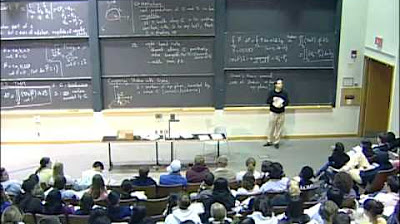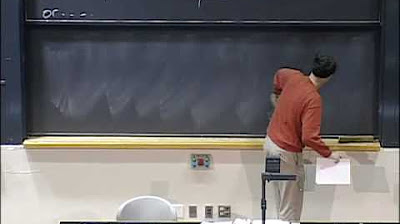Stokes' Theorem // Geometric Intuition & Statement // Vector Calculus
TLDRThis video delves into Stoke's Theorem, a key concept in vector calculus, building upon the viewer's understanding of Green's Theorem. The presenter introduces Stoke's Theorem by contrasting it with its two-dimensional counterpart, emphasizing the theorem's application to three-dimensional surfaces within vector fields. The video explores the relationship between boundary circulation and the curl of a vector field, highlighting the theorem's conditions and its significance in capturing the tendency of rotation within surfaces. The presenter promises to illustrate the theorem with concrete examples and discusses its connection to the upcoming Divergence Theorem.
Takeaways
- 📚 Stokes' Theorem is a significant concept in vector calculus, following the divergence theorem in the educational playlist.
- 🌐 The theorem involves a 2D surface embedded in 3D space, with a focus on the boundary and its interaction with a vector field.
- 🔍 Visualization of the vector field is simplified by showing only vectors originating from the surface and its boundary for clarity.
- 🔄 The concept of circulation is introduced, which is the movement around the boundary influenced by the vector field, calculated by the line integral of f dot dr.
- 📍 The normal vector's role is highlighted, indicating orientation on the surface and the influence of the vector field's curl on the surface's tendency to rotate.
- 🌀 The curl of the vector field at a point is represented by del cross f, and its dot product with the normal vector indicates the local swirling tendency on the surface.
- 📈 Green's theorem is a precursor to Stokes' theorem, operating in a 2D plane but setting the stage for the transition to 3D with Stokes' theorem.
- 🔄 Green's theorem is reformulated with the introduction of the curl, represented as del cross f dot k hat, where k hat is perpendicular to the xy plane.
- 📊 Stokes' theorem extends the concept to 3D, with the circulation around a boundary curve in three dimensions equated to the surface integral of the curl dot the normal vector.
- 📐 Conditions for applying Stokes' theorem include the need for a smooth or piecewise smooth surface and the requirement for an oriented surface to determine the normal vectors consistently.
- 🎯 The theorem's intuitive argument relies on the cancellation of internal curling effects, leaving only the boundary's curling to influence the circulation around the curve.
Q & A
What is the main focus of the video script about?
-The video script focuses on explaining Stoke's Theorem in the context of vector calculus, its relation to Green's Theorem, and how it generalizes to three-dimensional surfaces and vector fields.
What is the significance of Stoke's Theorem in the development of vector calculus?
-Stoke's Theorem is significant as it is considered one of the triumphs of vector calculus, providing a powerful tool for relating surface integrals to line integrals.
What is the role of the boundary in Stoke's Theorem?
-The boundary plays a crucial role in Stoke's Theorem as it is the focus of the line integral on the left-hand side of the theorem, representing the circulation around the boundary curve.
How does the script differentiate between the surface and its boundary?
-The script differentiates by highlighting the boundary of the surface and discussing the properties of circulation along the boundary, which is essential for understanding Stoke's Theorem.
What is the importance of the normal vector in Stoke's Theorem?
-The normal vector is important because it is used in the right-hand side of Stoke's Theorem to determine the tendency of the vector field to curl within the surface, subject to the constraint of remaining on the surface.
How does the script visualize the curl of a vector field in relation to the surface?
-The script visualizes the curl by imagining a particle on the surface with a normal vector, showing how the vector field influences the rotation or swirling at that point.
What is the relationship between Stoke's Theorem and Green's Theorem?
-Stoke's Theorem is a generalization of Green's Theorem, extending the principles from two dimensions to three dimensions, and from planar regions to surfaces in space.
What is the significance of the term 'circulation density' in the script?
-The term 'circulation density' refers to the difference of partials in Green's Theorem, which is rewritten in terms of the curl of the vector field when generalizing to Stoke's Theorem.
What are the conditions required for Stoke's Theorem to be applicable?
-The conditions for Stoke's Theorem include the vector field having continuous first partial derivatives of its components, and the surface being smooth or at least piecewise smooth, with a consistent choice of normals for orientation.
How does the script explain the cancellation of interior curling in Stoke's Theorem?
-The script explains that at any point in the interior of the surface, the curling tendencies cancel out because adjacent paths have flows that go up in one path and come back down in the adjacent path, leaving only the curling along the boundary.
What is the next topic the script mentions after discussing Stoke's Theorem?
-After discussing Stoke's Theorem, the script mentions the Divergence Theorem as the next topic, which is another important concept in vector calculus.
Outlines
📚 Introduction to Stokes' Theorem in Vector Calculus
The speaker introduces Stokes' Theorem as a culmination of the vector calculus series, emphasizing its importance alongside the Divergence Theorem. The concept is explored through the lens of a 2D surface within a 3D vector field, focusing on the boundary and the difference between the surface and its boundary. The video aims to clarify the theorem's idea by visualizing the surface within a vector field and discussing the circulation along the boundary, represented by the line integral of the vector field dot product with the differential displacement vector. The normal vector's role in the theorem is introduced, highlighting the oriented nature of the surface and the influence of the vector field's curl on the surface's rotation.
🔍 Deep Dive into Stokes' Theorem and Its Relation to Green's Theorem
This paragraph delves deeper into the specifics of Stokes' Theorem, contrasting it with Green's Theorem by transitioning from a 2D to a 3D perspective. The speaker explains the theorem's visualization, moving from a flat plane to a three-dimensional surface and vector field. The left-hand side of the theorem, representing circulation around the boundary curve, is contrasted with the right-hand side, which involves the curl of the vector field dotted with the normal vector, accounting for varying normals across the surface. The speaker also discusses the conditions required for Stokes' Theorem to apply, such as the need for a smooth or piecewise smooth surface and an oriented surface for consistent normal vector selection. The paragraph concludes with a promise of concrete examples and a segue into the Divergence Theorem, inviting viewers to engage with the content through likes and comments.
Mindmap
Keywords
💡Stoke's Theorem
💡Surface
💡Boundary
💡Vector Field
💡Normal Vector
💡Curl
💡Line Integral
💡Green's Theorem
💡Circulation Density
💡Oriented Surface
Highlights
Introduction to Stoke's Theorem as a culmination of vector calculus development.
Exploration of the concept of a two-dimensional surface in three-dimensional space and its boundary.
Discussion on the interaction between the surface and a vector field, focusing on the boundary curve and vectors originating from it.
Explanation of circulation along the boundary influenced by the vector field.
Introduction of the normal vector and its role in the orientation of the surface.
Illustration of the curl's effect on the tendency for rotation within the surface at a point.
Connection between the curl at the boundary points and the circulation around the boundary.
General formula for curling point calculation using del cross f.
Transition to Green's Theorem as a precursor to Stoke's Theorem, with a focus on two-dimensional scenarios.
Reformulation of Green's Theorem incorporating the curl with a new symbolic representation.
Visualization of curling tendencies in the vector field using spinners in the xy-plane.
Explanation of the interior cancellation of curling effects and the accumulation around the boundary.
Introduction of Stoke's Theorem with a shift to three-dimensional surfaces and vector fields.
Differences between Stoke's and Green's Theorems, particularly the use of the normal vector and surface integrals.
Conditions for Stoke's Theorem application, including the requirements for the field and surface smoothness.
Emphasis on the importance of an oriented surface for the computation of Stoke's Theorem.
Anticipation of concrete examples and corollaries of Stoke's Theorem in the next video.
Teaser for the upcoming Divergence Theorem as an extension of the other part of Green's Theorem.
Transcripts
Browse More Related Video

3D divergence theorem intuition | Divergence theorem | Multivariable Calculus | Khan Academy

Tensor Calculus Lecture 13b: Integration - The Divergence Theorem

Lec 31: Stokes' theorem | MIT 18.02 Multivariable Calculus, Fall 2007

Lec 22: Green's theorem | MIT 18.02 Multivariable Calculus, Fall 2007

Green's Theorem (Circulation & Flux Forms with Examples)

2D divergence theorem | Line integrals and Green's theorem | Multivariable Calculus | Khan Academy
5.0 / 5 (0 votes)
Thanks for rating: